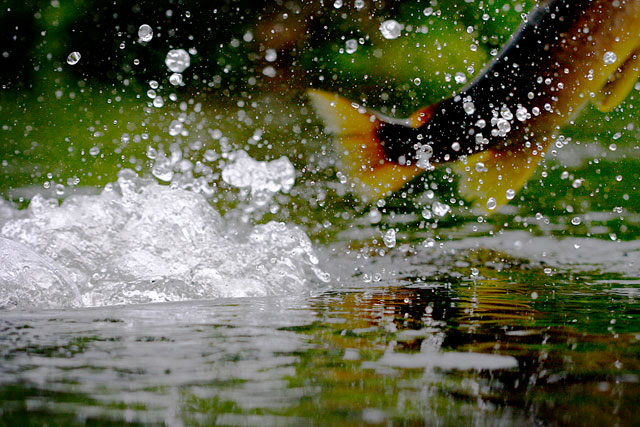Sending Back the Souffle

photo by Secret-Creek
It’s Monday morning, the first glorious day of spring break 2013, and I’m having an identity crisis. My shooting-head wallet is not yet dry, I’ve got a mess of soggy possum-head mega sculpins squirming at the bottom of my slingpack, and my switch rods are a game of Pick Up Sticks just waiting to be played in the rear windshield of my car. Nevertheless, here I am in Southwestern Wisconsin, a size 22 midge emerger latched to my three-weight, creeping over a snowy hill to a spring creek two cows’ lengths across. In the flat, sun-soaked water below a tail-out, wild browns are tippling their lunch. I can see them clearly in the afternoon sunlight, little browns the size and shape of plump cigars; they waver calmly in the slow current, rise dimplingly to dispatch one of the hundred or so insects they’ll eat that day, rest, digest, and repeat.
The contrast between this particular moment and the others that have been making up my fishing life of late is a little dizzying. Two weeks ago I was swinging beefy streamers and T-14 through late-winter runoff; next weekend I’ll be throwing musky-sized meat on 350 grain heads at browns with half-dollar spots and donkey DNA. I planned this trip thinking a little midging might be a nice change of pace, but a part of me is starting to fear it’s a case of too much too soon—or rather too little, too subtle, too soon. I feel like someone accustomed to scarfing braised bear and whisky now being served a soufflé and Chablis. It’s a tough transition, and I feel like I’ve skipped a step or two. Or, as I attempt a Turle knot with the 7x, three.
Taking these fish will require a downstream presentation, so I take to the ridge to get above them, flushing a turkey in the process. Re-entering the creek I move slowly into position and cast, but the tuft of CDC I had hoped to follow is no larger than a speck of sunlight, a fleck of foam, and there are many flecks and specks to contend with. As it enters the riffle I feel like I’m on the wrong end of a shell game, and set the hook at the next riseform I see. Nothing. Five similar drifts, still nothing. I decide to cheat a little, and hang a tiny peacock-herl soft hackle off the back of the dry. I let the rig swing out at the end of the next drift, and hook up with a little Cohiba of a brown. As delicately as I fight it, the battle puts the whole pod down.
After a quick release I stand there midstream, ruminating, deliberating. Fact: it has taken me twenty minutes and a lot of creeping, a lot of turning-into-the-Invisible Man, a lot of calorie-burning to catch this fish. Ahead of me, at the end of each riffle-hole-run sequence, there is the possibility of doing the same. The question is: do I really want this?
A few years ago the answer would have been a hands-down yes—and bring on a second helping, please. Needing to prove something (and we’ve all needed to prove something at some point in our angling careers), I would have sweated and suffered for those fish, taken one or two from each run, and complimented myself on my sophisticated palate, my finesse, my delicacy, my restraint. But now I feel entitled to be a little more honest with myself, and the truth is this: while I may very well enjoy the delicacy that is midge fishing in the future, right now I want to consume some brute aggression, I want to scarf down some deliberate nastiness, I want a stick-to-your-ribs type of experience. I don’t want many fish. Heck, I don’t even want two—I want one fish that wants to kill something. Having taken a bite of soufflé, I want to change my order to moose haunch, seared over an open fire, served in a bucket of gravy. So I trudge back to the car, grab my six weight and a few of my less gaudy steelhead sculpins, and head downstream to the bigger bends.
I bypass a few pods of risers till I arrive at the undercut bank I had in mind. I identify the sweet spot where the main current veers off, leaving a cozy, slack nook where the alpha fish of this bend will be holding. Then I start casting, feeling out the current, working my way to the sweet spot.
Before I even get there a good-sized brown flashes from behind a rock, knocking the sculpin off track but missing. Then does it again. I miss him twice, but my heart’s pounding. My second cast, right through the sweet spot, is met with a solid slam, a truly good fish, a fish so strong there’s a moment where I’m not sure I’ll be able to keep him from turning into a cutbank fugutive. But I do, and he eventually comes to hand, a nice 17-inch brown that decided he didn’t feel like eating midges that day. I feel a special kinship with him, and pay a high compliment as I breathe him back into the flow: “You’ve got damn good taste.”











